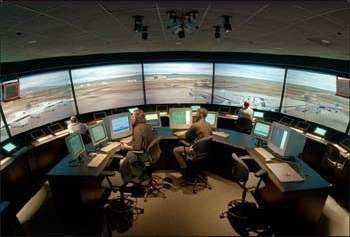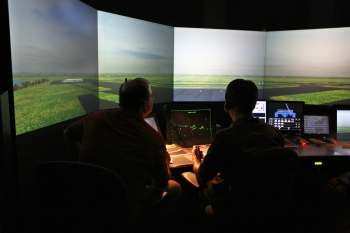Thu, Feb 07, 2008
Will Deploy Sims To 19 Airports, OKC Training Center
The Federal Aviation Administration (FAA) announced Wednesday it
will deploy new air traffic tower simulators to 19 locations around
the country to help train thousands of new air traffic controllers
in an operational environment that is interactive and provides
realistic scenarios.

The new simulators will be deployed over the next 18 months at
the following towers: John F. Kennedy (JFK); Los Angeles (LAX);
Oakland (OAK); Washington Reagan National (DCA); Dallas Fort-Worth
(DFW); Atlanta (ATL); Denver (DEN); Philadelphia (PHL); Cincinnati
(CVG); Cleveland (CLE); San Antonio (SAT); Memphis (MEM); Honolulu
(HNL); Orlando (MCO); Charlotte (CLT); Minneapolis (MSP); Boston
(BOS); and Newport News (PHF). The FAA will install an additional
six simulators at the FAA Academy in Oklahoma City (OKC).
 "We’re making sure that the
latest technology is part of the training regimen," said Bobby
Sturgell, the FAA’s acting administrator. "Controlling
traffic is a demanding job, and experience tells us that real-life
training scenarios make a critical difference. Deploying simulators
to such key locations as JFK will help us maximize our training
program."
"We’re making sure that the
latest technology is part of the training regimen," said Bobby
Sturgell, the FAA’s acting administrator. "Controlling
traffic is a demanding job, and experience tells us that real-life
training scenarios make a critical difference. Deploying simulators
to such key locations as JFK will help us maximize our training
program."
The FAA has been using tower simulators for training in Chicago,
Miami, Phoenix and Ontario, CA since 2006. In late December 2007,
the FAA awarded a contract to Adacel Systems, Incorporated of
Orlando, FL to provide another 24 simulators. Adacel, Inc.
developed the FAA’s original four prototype systems.
The Tower Simulation System (TSS) includes a large, graphic
depiction of the airfield and the area around the airport and can
be adjusted to depict different weather conditions and times of the
day. The screen showing the airfield wraps around the
student’s position to replicate windows of an actual air
traffic tower.
The simulator provides synthetic voice response and voice
recognition to allow the student to direct and receive responses as
they would in the tower. At the same time, the voice recognition
system interprets the student’s commands and translates them
into actual aircraft movements depicted on the screen of the
airfield layout.

The simulator system does not interact with actual air traffic
control operational systems and poses no threat to service
interruption. The system creates an entirely new environment that
operates away from and independently of ongoing air traffic
operations. It realistically replicates operations that enable
training in an absolutely safe environment.
More News
“Big Things Have Small Beginnings” Set for November 6–8, 2025 at Lakeland Linder International Airport (LAL) in Lakeland, Florida, the first-ever Affordable Flyin>[...]
“Backed by 90 years of Jeppesen’s gold-standard data and ForeFlight’s relentless spirit of exploration, this combination is building the most unified, intuitive p>[...]
“Our strategic partnership with AutoFlight, backed by their substantial technological expertise and tangible advancements in eVTOL airworthiness, represents a significant mil>[...]
Also: Beech M-346N, Metro Gains H160 EMS STC, New Bell Boss, Affordable Flying Expo Tickets NOW On Sale! Purdue University’s Research Foundation and the Archaeological Legacy>[...]
Aero Linx: British Gliding Association (BGA) The British Gliding Association is the governing body for the sport of gliding in the UK and members are the 76 clubs that provide glid>[...]
 1st Annual Affordable Flying Exposition Gets Its Footing
1st Annual Affordable Flying Exposition Gets Its Footing Aero-News: Quote of the Day (11.04.25)
Aero-News: Quote of the Day (11.04.25) Aero-News: Quote of the Day (11.05.25)
Aero-News: Quote of the Day (11.05.25) Airborne 10.30.25: Earhart Search, SpaceX Speed Limit, Welcome Back, Xyla!
Airborne 10.30.25: Earhart Search, SpaceX Speed Limit, Welcome Back, Xyla! ANN's Daily Aero-Linx (11.05.25)
ANN's Daily Aero-Linx (11.05.25)





